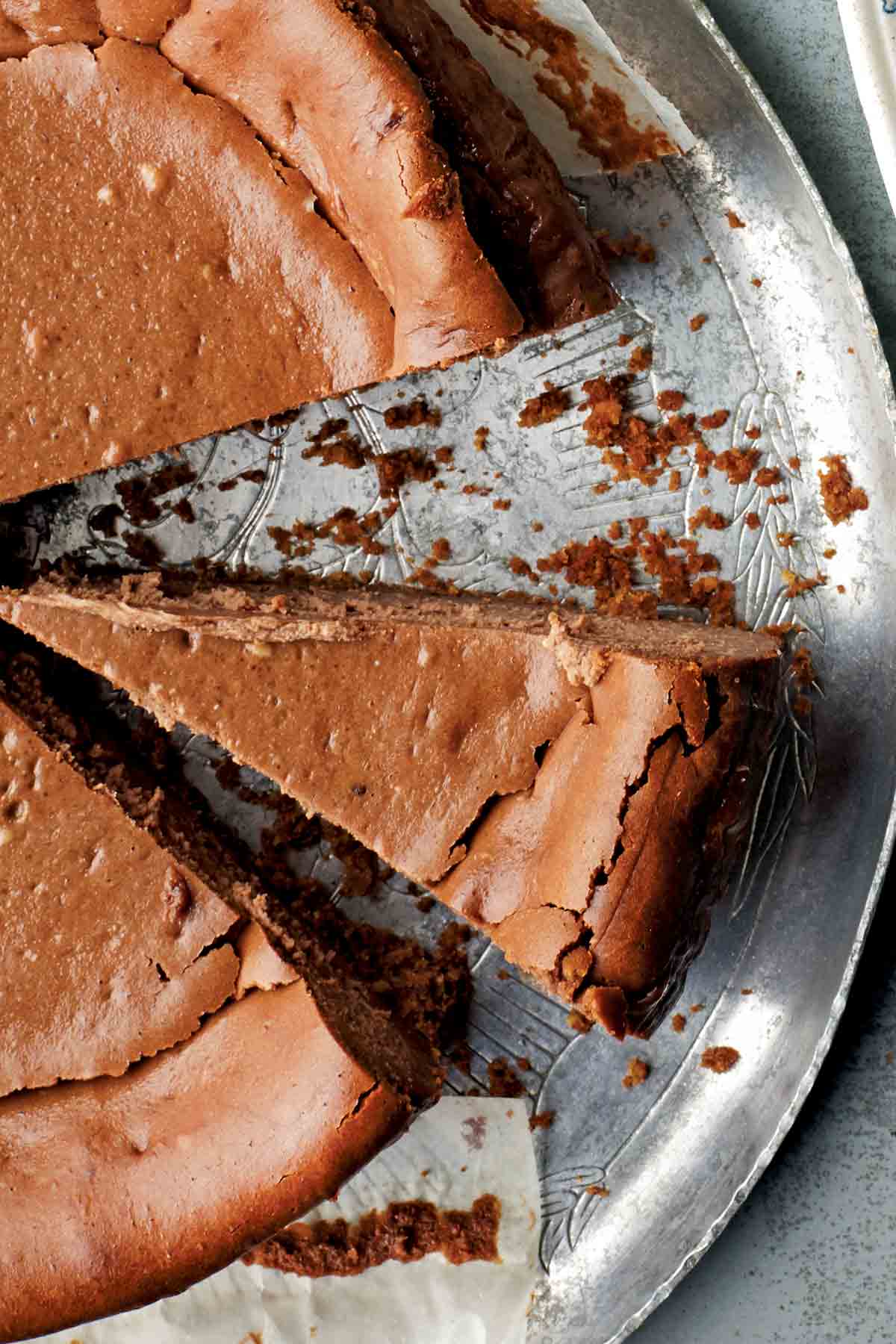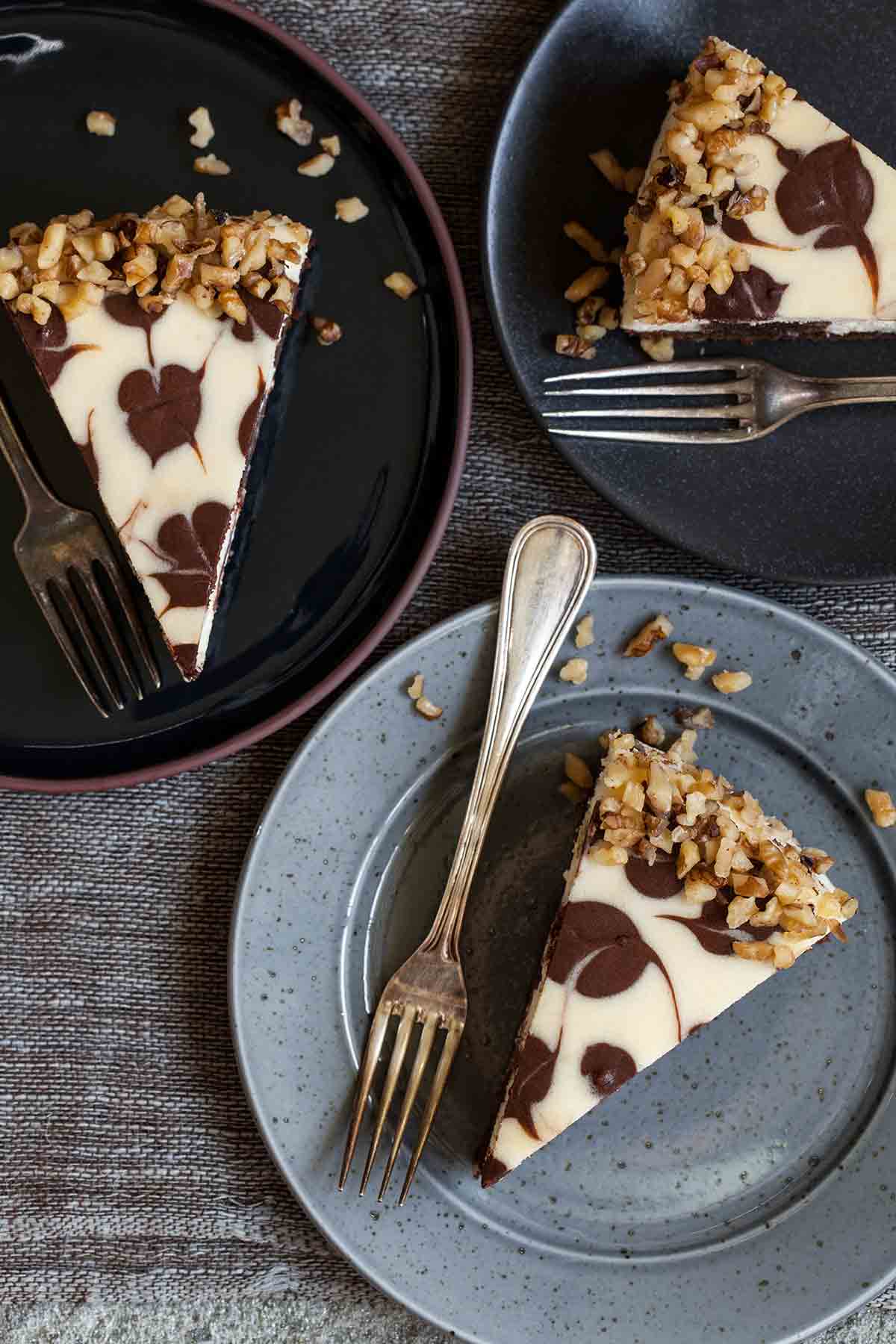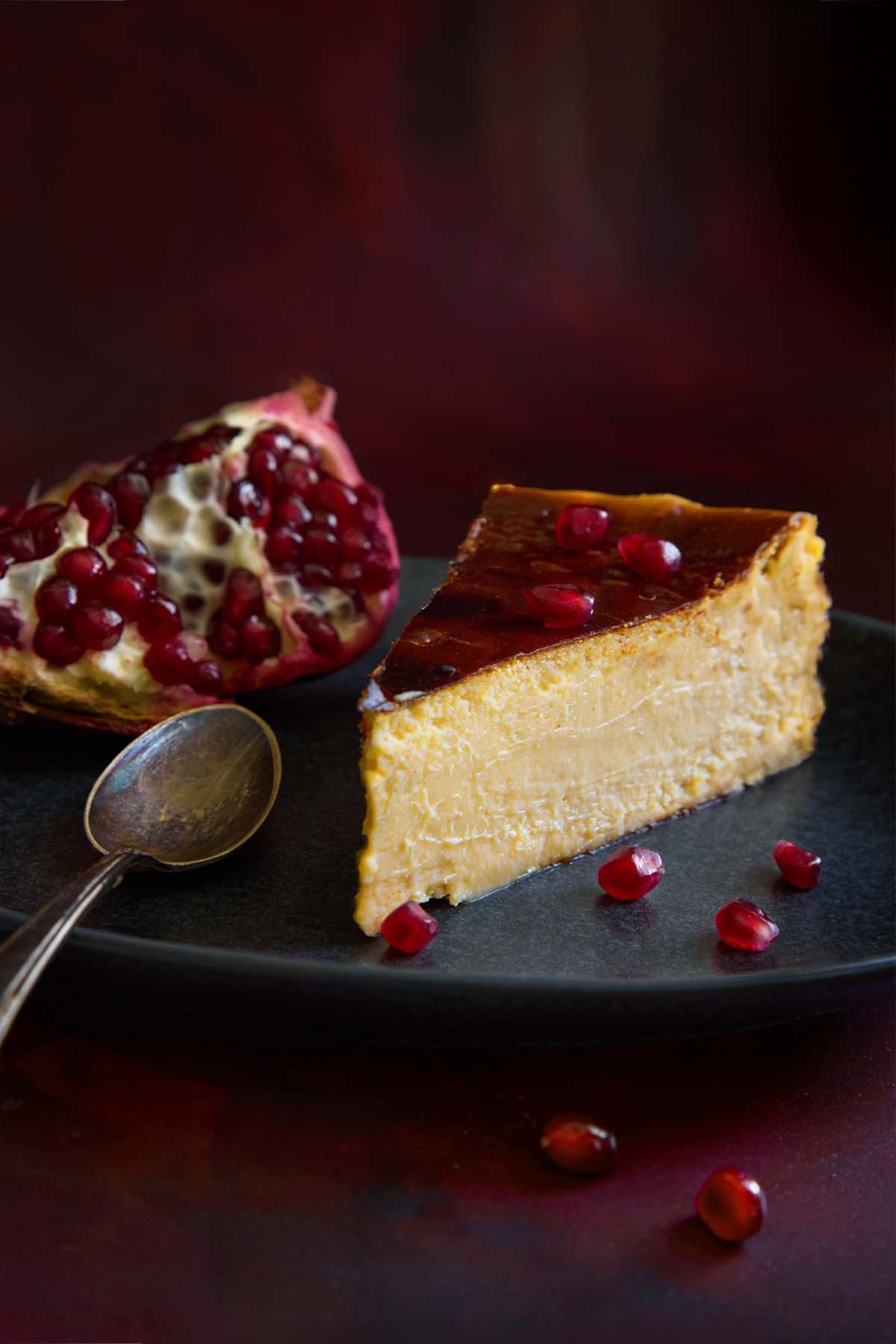
Jump To
- What is Burnt Basque Cheesecake?
- What Makes a Basque Cheesecake Different?
- Why This Recipe Works
- Notes on Ingredients
- How to Make This Recipe
- What is Pomegranate Molasses?
- What’s the Proper Texture of Basque Cheesecake?
- Your Basque Burnt Cheesecake Questions Answered
- Pro Tips
- Storage
- More Incredible Cheesecake Recipes
- Write a Review
- Burnt Basque Cheesecake with Pomegranate Recipe
- Recipe Testers’ Reviews
I fell in love with San Sebastián cheesecake when I visited northern Spain 20 years ago. Burnt, caramelized, and ridiculously creamy—Basque cheesecake is unlike anything else. Think flan, but richer.
But after eating my weight in cheesecake, I craved something more. Something unexpected. That’s when I turned to my secret weapon: pomegranate molasses. It adds a bold, tangy twist, with a bright citrusy edge that cuts through the ultra-decadent interior.
If you love cheesecake, this is your next must-bake dessert. If you don’t, this will convert you. No crust, no water bath—just a foolproof, golden masterpiece that melts in your mouth. And the best part? It’s incredibly easy to make and practically impossible to mess up—as long as you don’t overbake it!
What is Burnt Basque Cheesecake?
Basque cheesecake is a crustless, deeply caramelized cheesecake that originates from San Sebastián, Spain. Unlike traditional cheesecakes, it’s baked at a high temperature to achieve a signature burnt top while maintaining a lusciously creamy interior.
First created at La Viña, a small restaurant in the Basque Country, this dessert quickly gained global fame for its rich, caramelized flavor and foolproof baking method—no water bath, no crust, and no worrying about cracks.
What Makes a Basque Cheesecake Different?
Compared to a classic New York-style cheesecake, Basque cheesecake is lighter, silkier, and intentionally “imperfect.” Created in San Sebastián, Spain, this caramelized cheesecake bakes at a high temperature for a burnt, golden top and a custard-like center—a stark contrast to the dense, structured New York version.
| Feature | Basque | New York |
|---|---|---|
| Origin | San Sebastián, Spain | New York, USA |
| Crust | No crust, freeform, rustic look | Graham cracker or cookie crust |
| Temp | High (400–450°F) for caramelization | Moderate (325°F) with water bath |
| Texture | Custardy, ultra-creamy | Dense, firm |
| Look | Burnt, deeply golden top, often cracked | Smooth, pale top, no cracks |
| Flavor | Caramelized, slightly tangy, rich | Creamy, rich, vanilla-forward |
| Difficulty Level | Easy—no water bath, forgiving | Moderate—prebaking of crust, water bath |

Why This Recipe Works
This pomegranate Basque cheesecake recipe is all about quality ingredients and a simple technique that delivers big results. The generous amount of cream cheese gives it an ultra-creamy, melt-in-your-mouth texture, while a blast of high heat creates that signature caramelized crust. And then there’s my addition of pomegranate molasses—deeply tangy, slightly sweet, and gorgeously vibrant. It’s the perfect counterpoint to the rich, custardy interior. Best of all? It comes together with just a handful of ingredients and a food processor. No fuss, all reward.
Notes on Ingredients
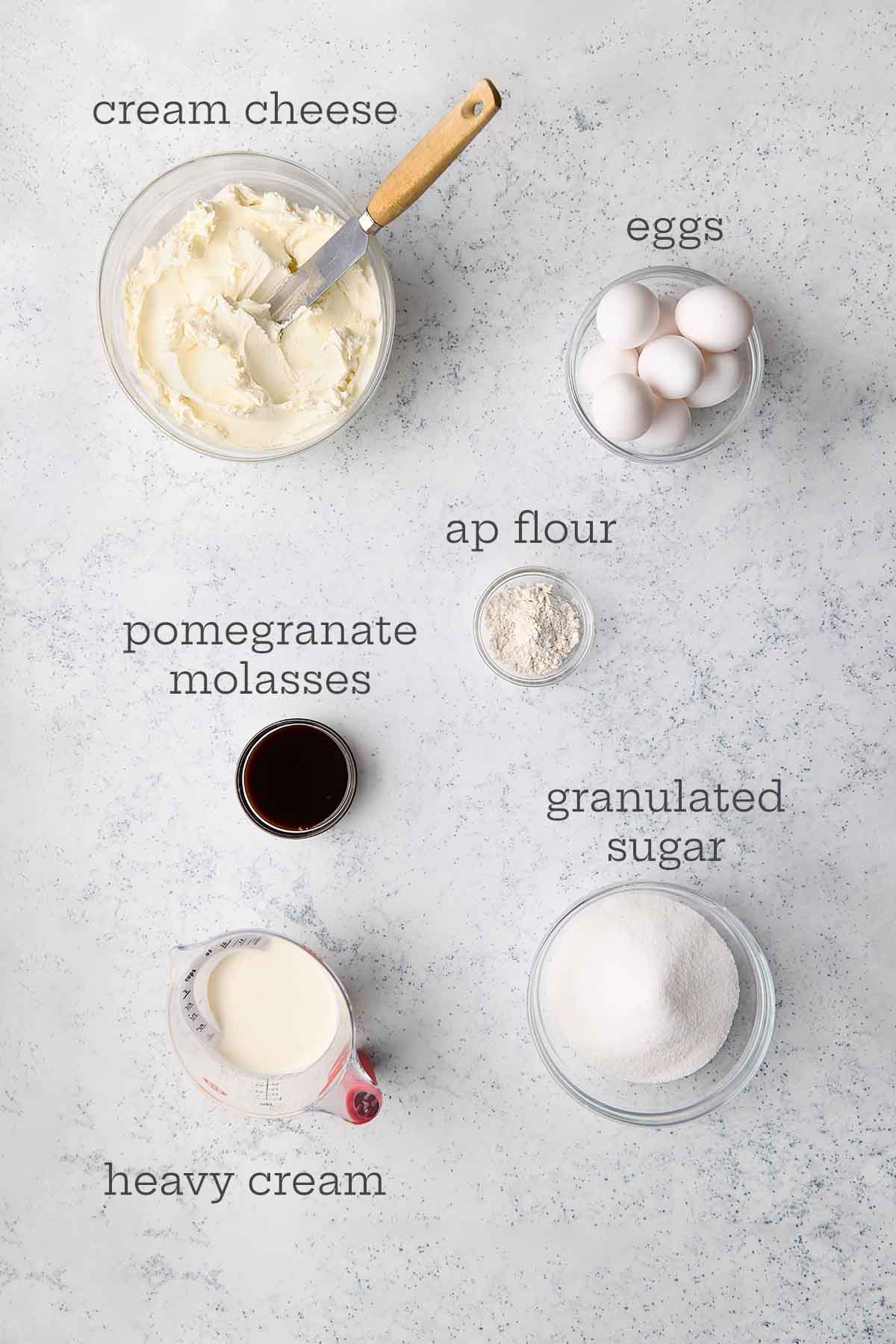
- Pomegranate molasses—This thick, tangy syrup is made from pomegranate juice and is commonly used in Middle Eastern cuisine. It adds a unique sweetness and acidity to the cheesecake. Look for it in Middle Eastern grocery stores or online.
- Cream cheese—For the best texture and flavor, use full-fat, block-style cream cheese. I use only Philadelphia Original Cream Cheese. I tested low-fat and cream-cheese substitutes, and they didn’t make the cut. Make sure the cream cheese is at room temperature for easy blending.
- Flour—All-purpose flour helps to stabilize the cheesecake.
How to Make This Recipe
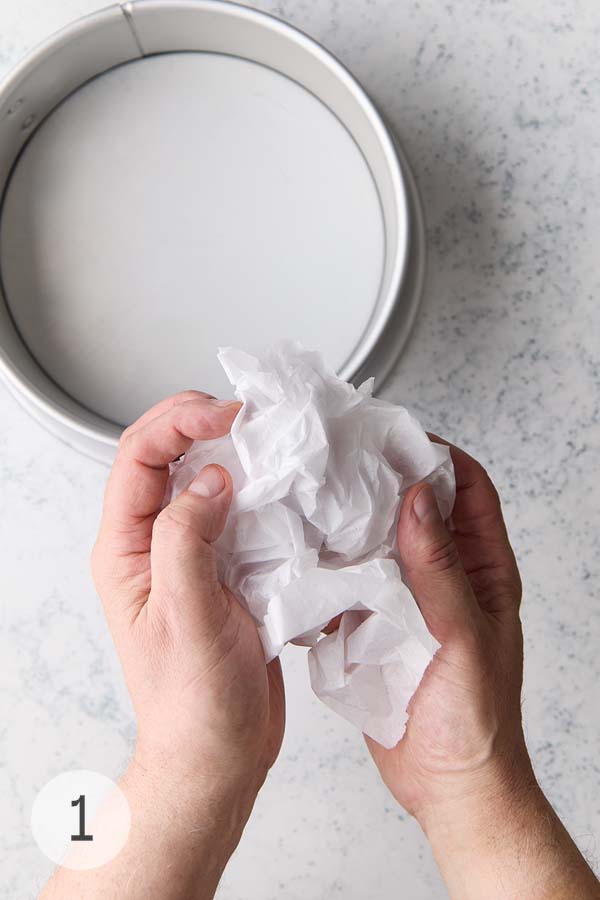
- Crumple a 15-by-15-inch piece of parchment paper, run it under water, then shake off the excess water.
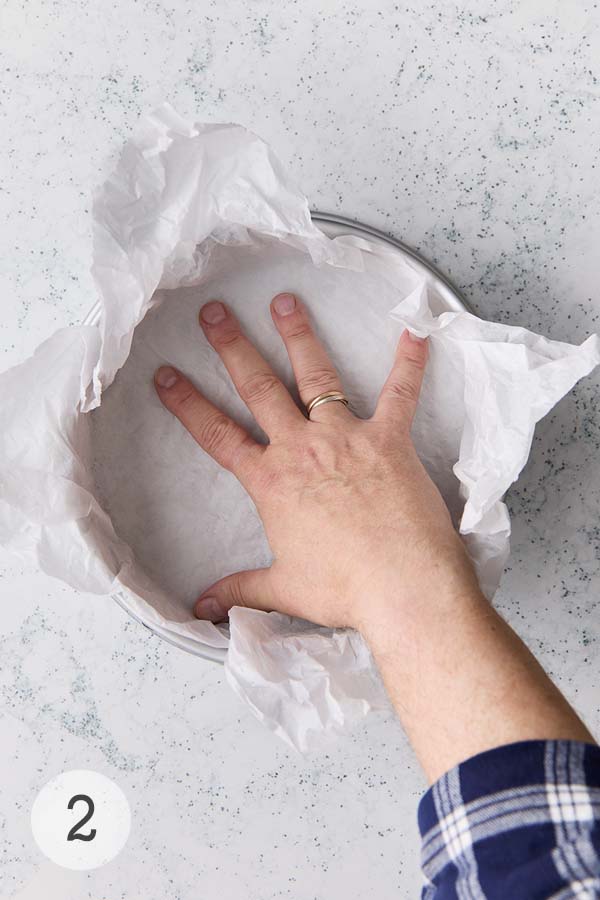
- Press the parchment into a 9-inch springform pan, letting the edges hang over.
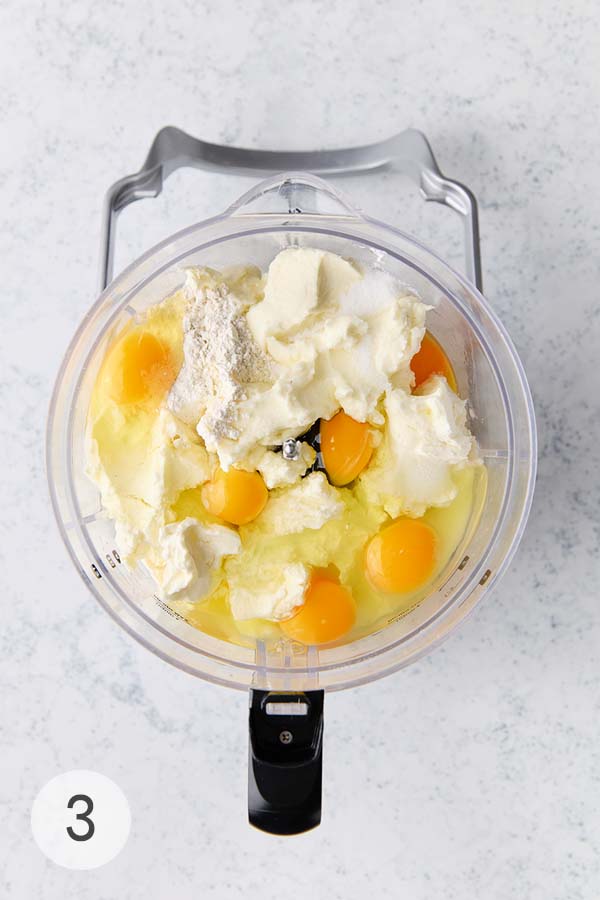
- Dump the eggs, sugar, cream cheese, and flour into a large food processor.
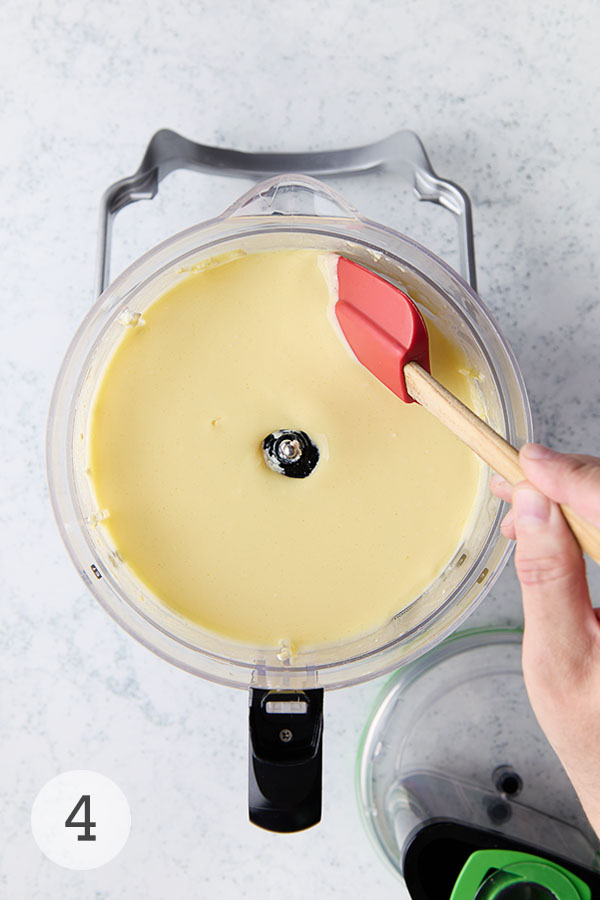
- Process until completely, totally smooth. Scrape down the sides of the processor often.
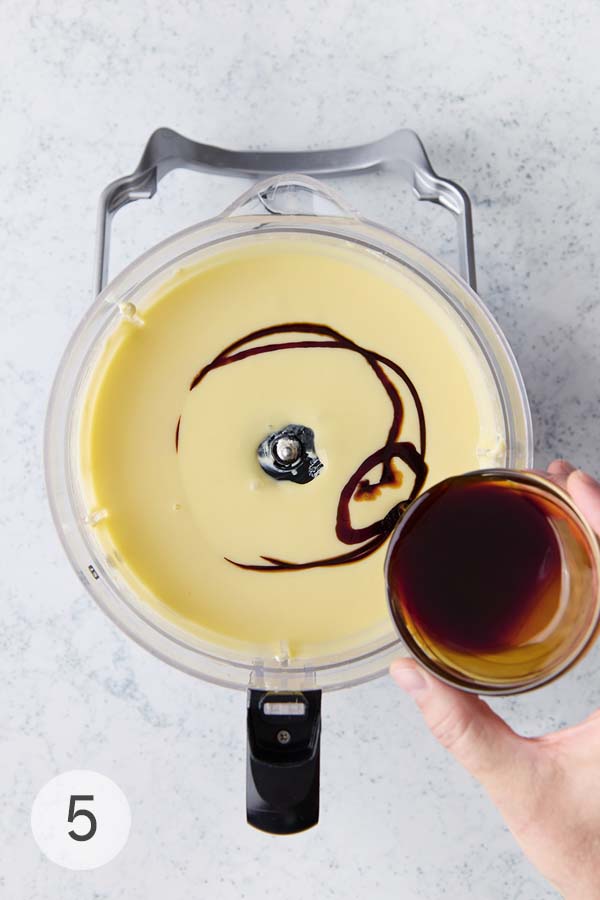
- Pour in the cream and pomegranate molasses; process until smooth.
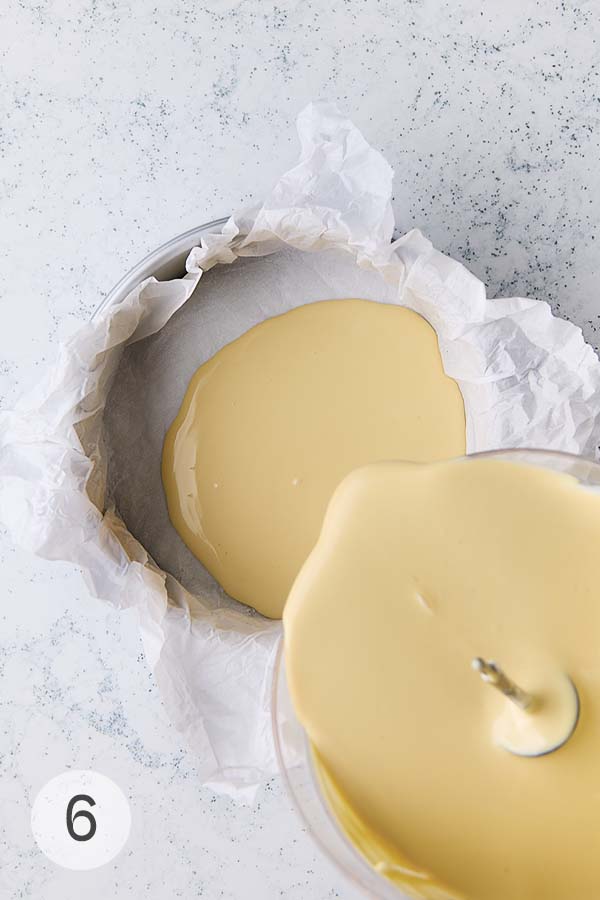
- Pour the cheesecake mixture into the prepared pan, and bake at 425°F (218°C) until it reaches 150°F (65°C). 40 to 50 minutes.
- Let the cheesecake cool completely in the pan, about 2 hours. Pop open the pan, pry the parchment from the cake, and enjoy!
What is Pomegranate Molasses?
Pomegranate molasses is a thick, sweet-tart (emphasis on “tart”) syrup made from pomegranate juice. It is widely used in Middle Eastern cuisine to add a sweet and sour flavor to dishes. It has a deep reddish-brown color and a concentrated pomegranate flavor.
What’s the Proper Texture of Basque Cheesecake?
Thanks for asking. I’ve seen many social media influencers pushing the narrative that the interior of the cake should be so soft and creamy that it’s runny. That’s not correct! San Sebastian-style cheesecake should have a deeply caramelized, almost burnt crust and a creamy, rich interior. The center should be very jiggly when it comes out of the oven, but it will set as it cools. The texture should be smooth, custard-like, and creamy, NOT runny or oozy.
Your Basque Burnt Cheesecake Questions Answered
Pomegranate molasses elevates the classic Basque cheesecake by adding a sweet-tart complexity that balances its rich, creamy interior. The deep, tangy notes cut through the indulgence, creating a more nuanced flavor profile. Instead of overwhelming the cheesecake, it enhances the caramelized top, bringing a subtle fruity brightness that complements the burnt sugar notes.
Absolutely not! No matter how long you beat the cheesecake batter, you’ll never get the smooth, ultra-creamy texture you get with a food processor.
If your food processor isn’t large enough to hold all the ingredients, process the recipe in two batches, and then pour the two batters into the pan. Really, it’s the only way.
Where to start? While the San Sebastian favorite is a delightful dessert on its own, you can elevate it. (Gild the lily, anyone?) Fresh berries, such as raspberries or strawberries, complement the tangy flavor of the cheesecake.
A dollop of whipped cream adds a wee bit of richness and sweetness. You can also drizzle some pomegranate molasses for an extra burst of flavor and a beautiful presentation.
If you’re feeling worldly, try pairing it with a glass of dessert wine, such as Moscato d’Asti. Its bright acidity and gentle effervescence cut through the richness of the cheesecake, while its fruity notes blend with the pomegranate.
Pro Tips
- Use room-temperature ingredients for a smooth batter.
- Let the cheesecake cool completely before serving for the best texture.
- Don’t overbake the cheesecake, or it will become dry.
- Use only 100% pure cream cheese. My preferred brand for this cheesecake recipe is Philadephia Cream Cheese.
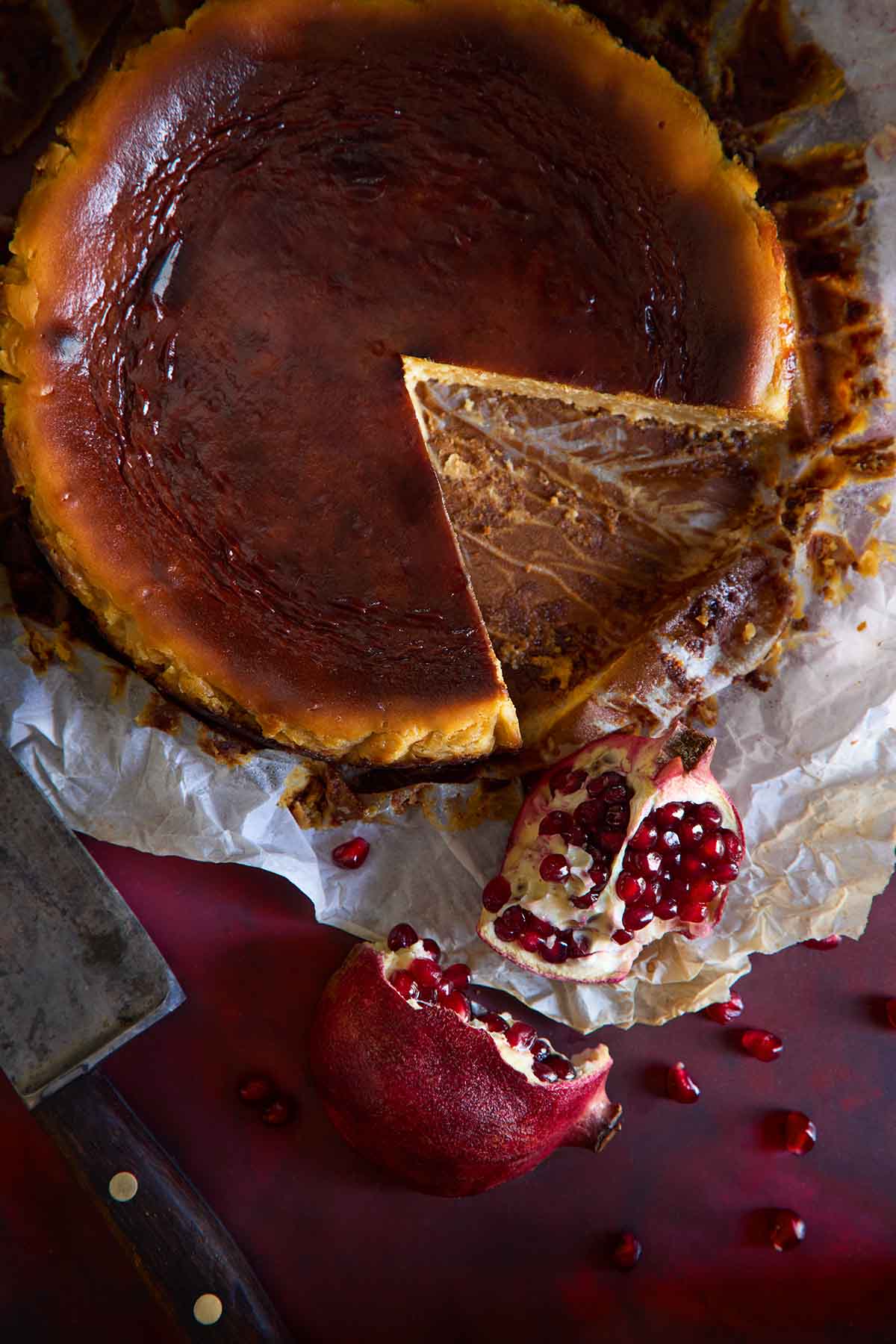
Storage
Store leftover cheesecake in the refrigerator for up to 5 days, covered tightly in plastic wrap. Let it come to room temp (about two hours) before serving.
For longer storage, you can freeze the cheesecake for up to three months. To maintain its quality when frozen, wrap the cake tightly in plastic and then foil to prevent freezer burn. When you’re ready to enjoy it, let it come to room temperature for about two hours before serving.
Write a Review
If you make this recipe, or any dish on LC, consider leaving a review, a star rating, and your best photo in the comments below. I love hearing from you.–David
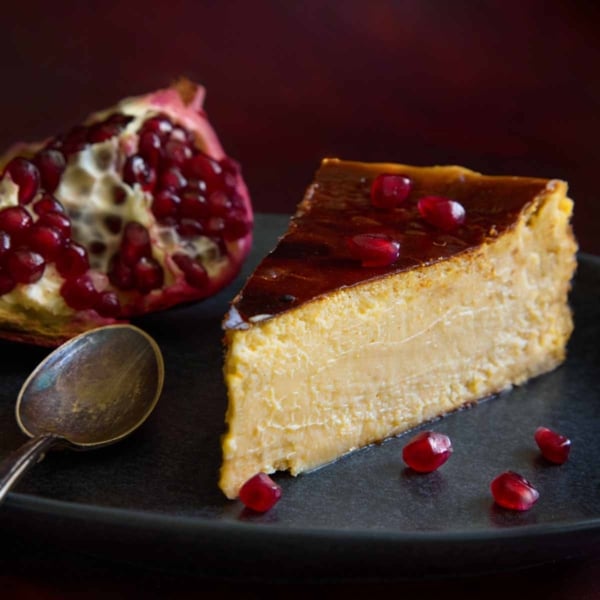
Burnt Basque Cheesecake with Pomegranate
Equipment
- 9-inch springform pan Fat Daddio's has high sides and a wide bottom
Ingredients
- 8 large eggs, room temperature
- 2 cups granulated sugar
- 2 ¼ pounds (36 ozs) Philadelphia brand cream cheese, room temperature, cut into 2-inch chunks
- 3 tablespoons all-purpose flour
- good pinch salt
- 1 cup heavy cream, room temperature
- ⅓ to ½ cup pomegranate molasses, if you like a wallop of citrus flavor opt for the ½ cup
Instructions
- Place a rack in the middle position of the oven and crank the heat to 425°F (218°C).
- Crumple a 15-by-15-inch piece of parchment paper into a loose ball, then run it under water to make it more pliable. Shake off the excess water.
- Press the parchment into a 9-inch springform pan, letting the edges stick up over the sides. Set the pan on a baking sheet.
☞ TESTER TIP: The baking sheet helps prevent the bottom from burning due to the extra sugar in the pomegranate molasses.
If you like, you can trim the parchment an inch or two above the rim of the pan. - Dump the 8 large eggs, 2 cups granulated sugar, 2 ¼ pounds (36 ozs) Philadelphia brand cream cheese chunks, 3 tablespoons all-purpose flour, and a good pinch salt in the bowl of a large (14-cup) food processor.
- Blitz the mixture until perfectly smooth, 3 to 4 minutes, stopping a few times to scrape down the bowl.
- Drizzle in the 1 cup heavy cream and ⅓ to ½ cup pomegranate molasses, and whir it until fully incorporated, about 30 seconds.
- Pour the batter into the parchment-lined springform pan.
- Slide the baking sheet with the pan into the oven and bake until the top is beautifully browned and the internal temperature registers 150°F (65°C) on an instant-read thermometer, 40 to 50 minutes.The cheesecake will be crazy jiggly in the center. As long as it hits the correct temperature, you're golden.
☞ TESTER TIP: If the top of the cake isn't as caramelized as you'd like, you can run it under the broiler for 30 seconds at a time. But whatever you do, DO NOT step away. It can go from a beautiful mahogany to bitter black in seconds.
- Remove the cake from the oven and let it cool completely on a wire rack, about 2 hours. It'll collapse slightly as it cools—that's as it should be.
- To serve, gingerly pull the parchment from the sides of the cheesecake. Dip a sharp knife in hot water, dry it, and cut the cake into slices. Dunk and dry the dry before each slice.
- To store, cover the cheesecake with plastic wrap and slip it into the fridge for up to 5 days. Yank it from the fridge 2 hours before serving.
Notes
- Parchment hack—I use Kirkland’s parchment because it’s 15-inches wide. If your parchment is narrower, use two overlapping sheets. Just make sure you have a 15-by-15-inch square.
- Ingredients—Make sure all the ingredients are at room temperature for a smooth batter. Sit them out 2 hours before baking.
- Don’t skimp—Speaking of ingredients, use only 100% real, full-fat cream cheese. I use only Philadephia Cream Cheese for this recipe.
- Chill out—Let the cheesecake cool completely before serving for the best texture.

An LC Original
View More Original RecipesNutrition
Nutrition information is automatically calculated, so should only be used as an approximation.
Recipe Testers’ Reviews
This summer, I had the original San Sebastian cheesecake in Spain at La Viña. It was different from the cheesecake that we usually make in the States—much creamier. And although a slice will stand up, it is wobbly.
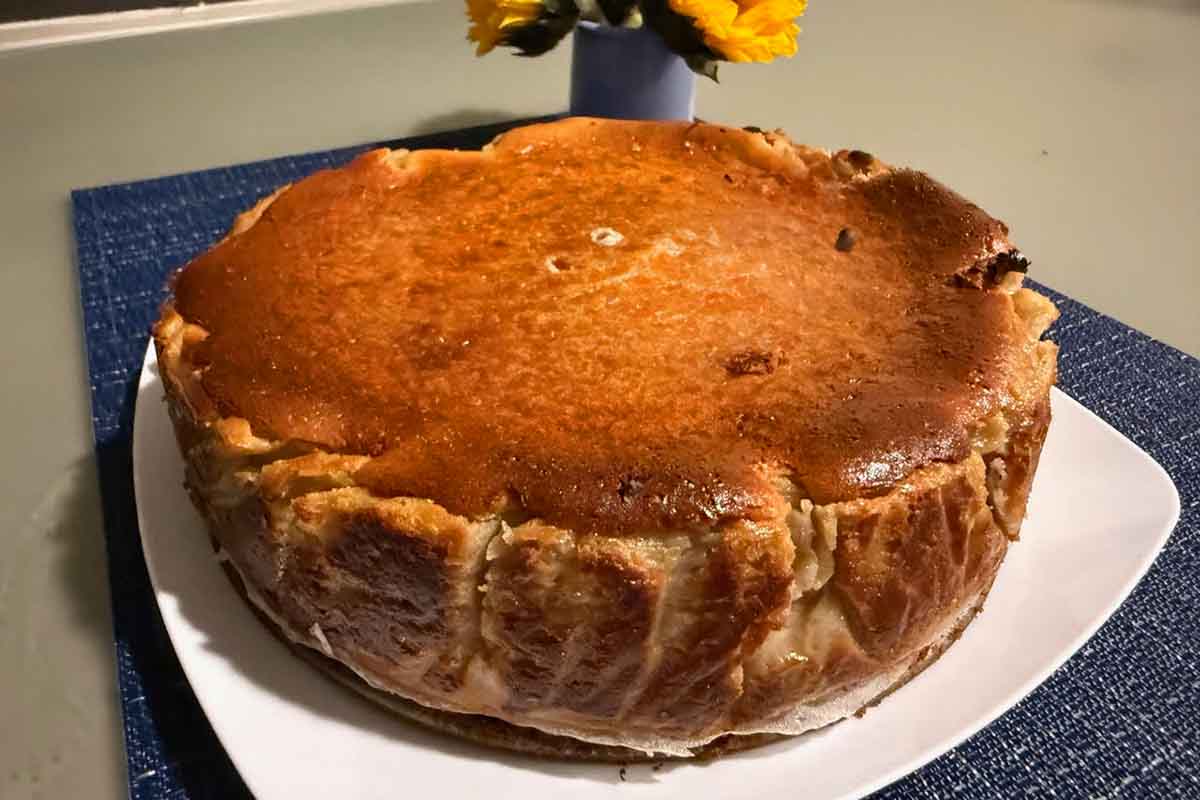
Until now, I haven’t been able to duplicate the texture. But I was delighted to see this burnt Basque cheesecake with pomegranate has that same wonderful texture. It’s so smooth and creamy it simply melts in your mouth. And so quick and easy to make.
I used 1/3 cup of the pomegranate molasses—what a wonderful addition. The taste was a very slight pomegranate with a tinge of citrus. Simply delicious.
